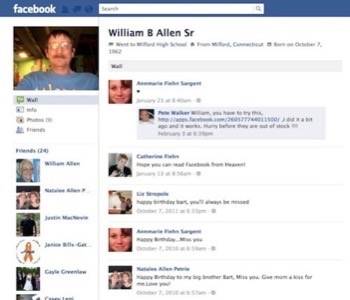Signing up for a free social networking account is easy. A few clicks and there you go – open up your Facebook, Twitter, LinkedIn and Google+ accounts. Get connected. The last thing on your mind is what will happen to those accounts after you leave this world. And not one of those networks, in their fast-paced Internet here-and-now, asks you to think about this, either.

“It’s like being 16 and signing up for a driver’s license, and then you see the organ transplant question. And you think to yourself ‘No, I’m going to live forever!” says Ken Abbott of the digital security company GEMALTO. “It’s a tricky question.”
On the Internet as in real life, no one lives forever. Not even Whitney Houston. So how can one deal with the mess of cleaning up a digital life before the person actually dies, rather than after the fact?
The “Social Grief “Mourning Process on Facebook
“The stages of grieving the death of a loved one generally consist of shock, denial, anger, mourning and finally, recovery,” explains Dr. Ashwini Nadkarni, co-author of the study “Why Do People Use Facebook?” “During the earlier stages of grieving, the online presence of the deceased can serve as a powerful visual reminder, enabling friends and relatives to relive the tragedy in a far more vivid fashion than if they had relied on memory alone.”
Initially, Facebook memorials and groups can serve as a pleasant reminder of the deceased. Yet as the grieving process continues, and the mourner moves on, that dead relative or friend could soon turn into a Facebook zombie.
Connecticut-based beauty pageant photographer Catherine Fiehn is somewhat of a celebrity in her niche of the woods. She has reached the 5,000 Facebook friend limit – and one of those friends is her deceased cousin.
“I struggle a bit with this everyday,” Fiehn writes. “My cousin’s Facebook profile shows up in my top 10 friends I’m closest to. People have been tagging photos of him so it’s become a memorial, but it’s kind of unsettling to see him on there everyday.” Still, she will not delete the profile.

The Afterlife is Not an Afterthought
In 2008, Troy Berg got to thinking about his new role as a father. “I had a son and I got to thinking, I started to do the transition from being a bachelor to a family-oriented guy. I started wearing my seat belt, I took out a life insurance policy. I started doing things to protect my family.”
One thing that occurred to him, which he was quite worried about, was the digital legacy he might leave behind if he dropped dead the next day.
“When I was growing up we had shoeboxes of photos, legacy stuff,” Berg says. “Now we’re sitting around with a bunch of harddrives filled with photos – so if something happened to me, there’s a chance that I’ll be completely gone.”
According to Facebook’s policy, people who are not the owners of a profile cannot download the data. So families of the deceased are left with the decision either to leave the profile as a memorial, or contact Facebook and ask them to take it down. Berg saw that problem and decided to address it head on. His service, LivingStory, creates an online memorial repository of sorts that is secure, family-centric and forever. There is no monthly fee. You pay one time, and your account is alive forever. You can sync the LivingStory account with a Facebook profile and Picasa photo account, and it will transfer photos to a stable site. You can also edit out the images that perhaps shouldn’t be memorialized. It is still in development on Flickr.
“Back in January, a good friend of mine died in an car accident, and I’m looking at her wall right now and it’s just sad,” says Berg. “All the photos will stay up there, and there are lots of photos I know she wouldn’t want to stay up. Like her doing a beer bong.”
LivingStory launched in 2008, and was flooded with 25,000 users in the first six months. The overwhelming interest took the site down, but Berg says that they are planning to relaunch in April 2012 with upgraded servers and technology.
“My Facebook profile is covered in funny cat pictures and videos, and those don’t belong in our lifeline, our timeline – and Facebook is a way to communicate instantaneously,” Berg says. “LivingStory archives your social life and saves the important things, and not just funny cat pictures.”
What’s a Mortal Social Networker To Do?
Writing down passwords on a sheet of paper and handing it over to a family member is one low-cost way to go.
“Personally what I’ve done – though I don’t think it’s such a great idea – is to list the accounts I have and put that into an encrypted document. But how secure is that?” asks Abbot. “The problem with that is that we should all be updating those passwords on a regular basis, so that’s probably not the best long-term strategy. I’m also not exactly sure that strong authentication techniques are necessarily the best way.”
Isn’t it up to Facebook, Twitter, LinkedIn and Google+ to determine what to do with the remains of their users?
“So maybe one of the things you were mentioning – you need to designate somebody who is kind of an executor who would have defacto access to those accounts. Maybe there needs to be a standard sort of thing, like an additional policy. When you sign on, instead of an alternate with what’s your mother’s maiden name, maybe not right off the bat, but after you’ve been active for a few months the service asks you who you would designate.”
In Nebraska, there’s a law pending which could solve this problem entirely by giving representatives legal possession of Facebook profiles, Twitter accounts and other online information. Soon, your passwords could become a standard part of your digital will. Until then, the ghosts of Facebook, Twitter, LinkedIn and Google+ continue to roam the social networked afterlife, slipping amongst the living like ghosts.
Image courtesy of Shutterstock.
















